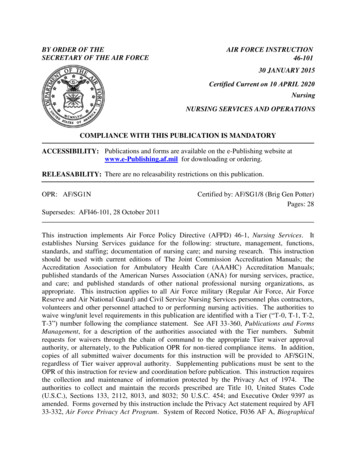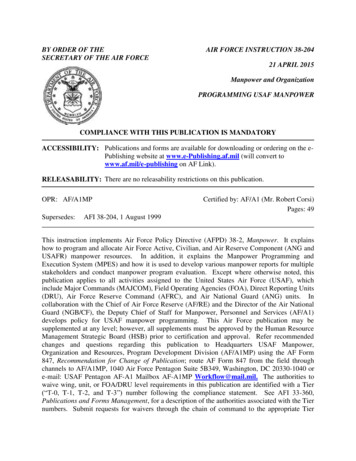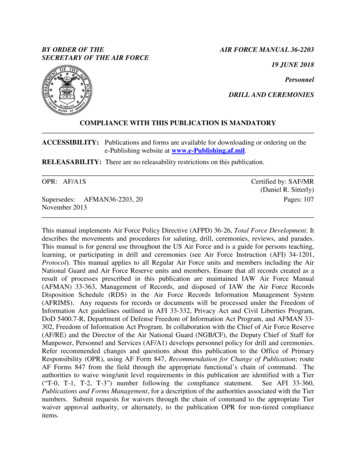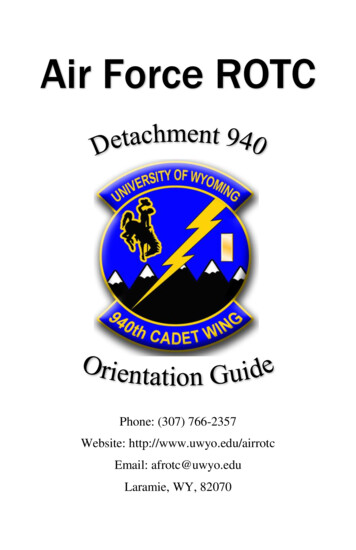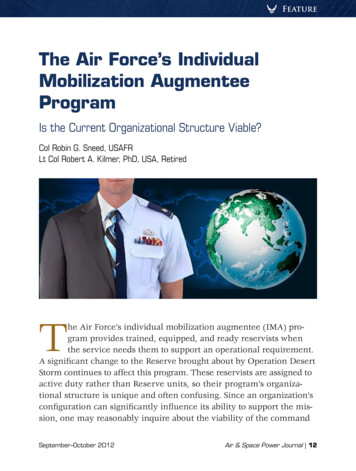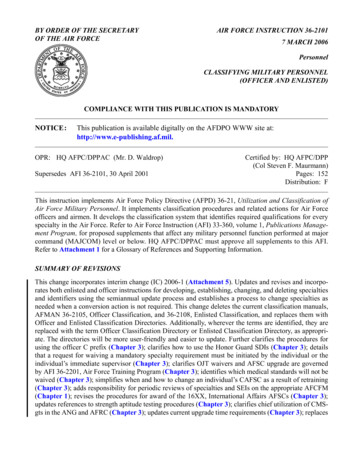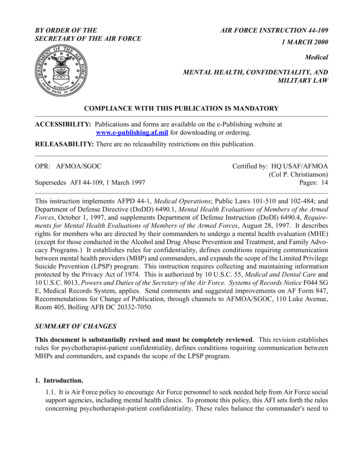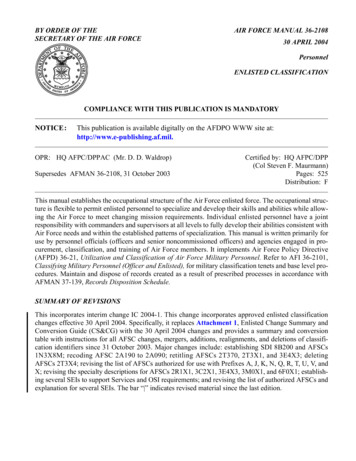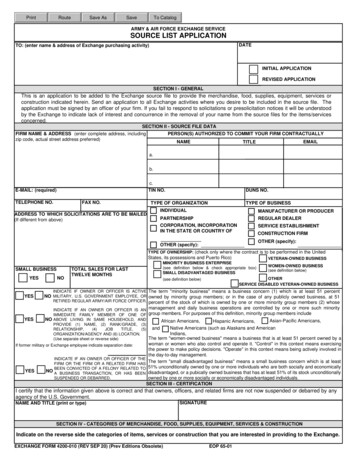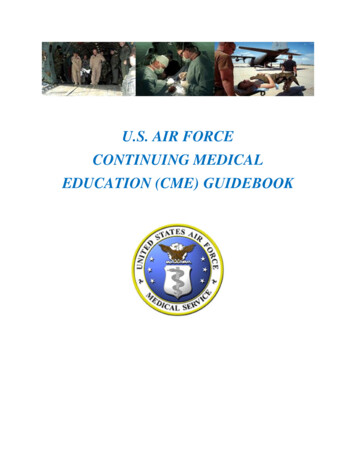
Transcription
U.S. AIR FORCECONTINUING MEDICALEDUCATION (CME) GUIDEBOOK
TABLE OF CONTENTSCME Mission StatementCME Website and Functional Users Certification of CME Activities Content of CMEThe CME application TimelinesLearning ObjectivesTarget AudienceCME Funding and Commercial SupportPolicy on Disclosure and Faculty Disclosureo ACCME Flowchart- Resolving Conflicts of Interesto ACCME Mechanism for Resolving Conflicts of Interesto Making Actual Disclosure to Activity AudiencesActivity EvaluationsEnduring Materialso Enduring Materials/Internet Enduring/ChecklistRequired StatementsCME CertificatesOrganization and Maintenance of CME FilesLearning Associated with TeachingGlossaryAcronyms
LINKSACCME's Accreditation Criteria itation-criteriaACCME's Standards of Commercial Support rds-for-commercial-supportAMA's Code of Medical hics/code-medical-ethics-overviewAMA's Gifts to Physicians from ethics/gifts-physicians-industryAMA PRA Recognitions Award Handbook, 2017 /files/corp/media-browser/public/cme/prabooklet 0.pdfAF CNE site:https://education.mods.army.mil/afncne/
AIR FORCE CME MISSION STATEMENTTo provide Air Force healthcare professionals opportunities to expand their professionalcompetence, readiness skills and understanding of medicine through participation in accreditedCME activities.The CME program has been created to facilitate the continuous learning process that ensureshealthcare professionals’ readiness to practice in a myriad of challenging environments aroundthe world, some potentially dangerous. All healthcare professionals within the United StatesDepartment of Defense (DoD) are the customers of the CME program and must be prepared tomeet the needs of the military fighting forces, as well as family members and retirees whorequire care.The CME office is responsible for maintaining ACCME accreditation, as well as educating andassisting the local CME planners at Air Force medical treatment facilities and other agencies inthe process of developing, tracking, and planning for educational courses, in support of theoverall Air Force Medical Service goal to maintain and enhance high-quality health care.Furthermore, the CME office approves educational activities conducted by local CME plannersthroughout the Air Force. These planners develop training that encompasses the entire spectrumof Air Force medicine, ranging from combat casualty care to administration, leadership andenvironmental health issues, with updates on technology, managed care and other medical issues.Activities developed and approved by the Air Force include lecture series, grand rounds,seminars, symposiums, advanced life support courses, enduring materials and internet basedactivities. Finally, the CME office has developed a comprehensive framework to evaluate eacheducational activity to enable future improvement, and to abide by the ACCME Essential Areasand Elements requiring documented changes in knowledge, competence, performance or patientoutcomes.
CME PURPOSEThe purpose of the AF CME Program is to provide Air Force healthcare professionalsopportunities to expand their professional competence, readiness skills and understanding ofmedicine through participation in accredited CME activities.Content Areas: These planners along with their MTF’s develop training that encompasses theentire spectrum of Air Force medicine, ranging from combat casualty care to administration,leadership and environmental health issues, with updates on technology, managed care and othermedical issues.Target Audience: All healthcare professionals within the United States Department of Defense(DoD) are the customers of the CME program and must be prepared to meet the needs of themilitary fighting forces, as well as family members and retirees who require care.Types of activities: Activities developed and approved by the Air Force include lecture series,grand rounds, seminars, symposiums, advanced life support courses, enduring materials andinternet based activities.Expected results of the program, articulated in terms of changes in competence, performance, orpatient outcomes.The CME program has been created to facilitate the continuous learning process that ensures AirForce Healthcare professionals readiness to practice in a myriad of challenging environmentsaround the world, some potentially dangerous.The CME office has developed a comprehensive framework to evaluate each educational activityto enable future improvement, and to abide by the ACCME Essential Areas and Elementsrequiring documented changes in physician knowledge, competence, and performance or patientoutcomes.
CME WEB SITE AND FUNCTIONAL USERSThe Continuing Medical Education Program Management System's Web Site is dedicated tosupporting the Air Force's CME program by automating the retrieval and querying activityinformation. The web site will provide physicians with a list activities created by the individualAir Force facilities. The CME website will contain the Air Force's CME Mission Statement,objectives, policies and regulatory guidance. The web site will also provide administrative andreporting support for Course Directors and Planners of CME activities. Below lists different usertypes and roles in CME.Air Force CME Director: Accredited CME provider by the Accreditation Council onContinuing Medical Education. The Air Force CME Office administers the CME Program and isthe proponent for CME policies and procedures. Has responsibility for maintaining theaccreditation and functionality of the CME website. When the CME Director leaves the position,a new CME Director may be appointed by the Director of Medical Education or by theleadership.Course Director: Clinicians who are subject matter experts and are responsible for the contentand execution of a CME activity. This includes building the agenda, identifying presenters andcommittee members, conducting a gap analysis, objectives, evaluations and outcomes andproviding guidance to the CME Planner and its learners. When the Course Director leaves theposition, a new Course Director will be appointed by the predecessor or by the leadership.CME Planners: Individuals designated as planners will have access to the CME Planners areaof the CME Web Site. The planning area includes all application types and planners will be ableto choose which application suits the activity being planned. Planners are responsible forcompleting the CME application in its entirety and will engage the Course Director who is thesubject matter expert for assistance in any part of the process. When CME Planner leaves theposition, a new CME Planner may be appointed by the predecessor or by the leadership.Participants: The learners of a CME activity. All individuals accessing the CME Web Site willhave the ability to view a list of the current activities being offered. This list will show thefacility providing the activity, its location, the dates and the credits awarded. Detailedinformation for an activity will be available when the participant selects a specific activity.Information displayed will include the activity objectives and faculty presenters. All attendeesare required to register on the CME website to attend a CME activity.System Requirements and Access: All users must create a profile. This one-time process willproduce a logon ID and password which is needed to access the CME website. Common AccessCard (CAC) will be enabled for those who have a CAC card and who possess an @mail.milemail address. Users must have internet access with a browser MS Explorer 8.0 or better.
CERTIFICATION OF CME ACTIVITIESThe U.S. Air Force is accredited by the Accreditation Council for Continuing Medical Education(ACCME) as a provider of continuing medical education (CME) for physicians. As such, thereare certain standards and rules by which the Air Force Medical Service must operate.The CME Website: Both the ACCME and the U.S. Air Force require that a standard planningprocess be utilized in the development of a CME activity. This standardized process assures thatresources spent on educational activities meet the identified needs and gaps of participants andexperts in the field. The key to planning a CME activity is to document the linkage between theidentified gap(s), the development of overall activity learning objectives, the faculty'sdevelopment of their sub-objectives, and the overall educational design of the activity. As such,the Army/Air Force MODS CME website will be used as the official web-based applicationsystem for certifying all CME activities within the Air Force.General Information/Definition of CME: Activities which may qualify for certification ofCME credit should “serve to maintain, develop or increase knowledge, skills, and professionalperformance and relationships that a physician uses to provide services for patients, the public, orthe profession. The content of CME is the body of knowledge and skills generally recognizedand accepted by the profession as within the basic medical sciences, the discipline of clinicalmedicine and the provision of healthcare to the public.”This broad definition of CME recognizes that all continuing educational activities which assistphysicians in carrying out their professional responsibilities more effectively and efficiently areCME. For example, a course in management would be appropriate CME for physiciansresponsible for managing a health care facility; a course in educational methodology would beappropriate CME for physicians teaching in a medical school; a course in practice managementwould be appropriate for practitioners interested in providing better services topatients. Documentation for all CME activity planning is crucial. Pay special attention todocumentation for the following: Identifying general, focused or other need/gaps for the activityDevelopment of objectives based on the identified needs/gapsFaculty guidance - conveying the identified need and learning objectives to the faculty forappropriate development of their presentation.CME Certification Procedure: In order for the Air Force to designate an activity for CMEcredit, the following procedures must be employed and documented on the web: Identify gap analysis or need through one or more of the following mechanisms:Survey of target audienceSelf-assessment testsHigher Headquarters DirectiveEvaluation data from previous, similar activities
Patient care audit/QA reportsMortality/morbidity statisticsPeer-reviewed abstractsFaculty perceptionDiscussion with/consensus of expertsInterviews with practitionersReview of literature and trends in the professionSuggestions from past program participantsSpecial advisory committee recommendationsIdentify target audience.Maintain complete documentation of activity planning.Develop activity learning objectives based on identified needs.Develop agenda and method of instruction designed to meet activity objectives.Identify faculty competent in the subject matter and qualified by experience, training and/orpreparation to the tasks and methods of delivery.Identify committee competent to control and/or influence the contents of the activity.Develop a post-course/activity evaluation to assess improvement of competence, change inperformance and/or patient outcomes.Awarding Credits: The Credit Designation Statement is a required item in any activity'sbrochure or other promotional materials, as well as the course syllabus or handout materials.Refer to the Credit Designation section for the Credit Designation Statement.The Credit Designation Statement must be written precisely as stated without changing anycapitalization or making creative additions whatsoever. The “AMA PRA Category 1 Credit(s) ” phrase is a trademark symbol of the American Medical Association. As such, whenreferencing CME in CME materials and correspondence, the entire italicized phrase must beused.a. Why do you need to designate credit? Because the physician needs to know howmany credits he or she will earn by participating in the activity, and because the ability to attainCME credits is a leading draw to get the physician to enroll in the activity.b. What exactly are the credits that are given to physicians? CME credits go towardthe American Medical Association's Physician's Recognition Award (AMA/PRA). TheAMA/PRA Category 1 credits is awarded to a physician who submits an application for theaward with proof of participation. ACCME providers are accredited by the AccreditationCouncil for Continuing Medical Education (ACCME) to award AMA/PRA credits.c. How do you determine the amount of credit to designate? The Air Force CME staffare the only personnel that can officially designate credit. Credits are determined by the amountof time for the educational presentations, not including breaks, social activities or other agendaitems where there is no actual content being discussed. One hour or 60 instructional minutes
will be given one credit. Credits may be rounded up or down in quarter increments. A 20minute presentation is rounded down to .25 credits and a 25 minute presentation is rounded up to.50 credits.Approval: Only the Air Force CME Director or its designee may approve CME activities.Retroactive approval is prohibited.All activities are directly approved for credit by the Air Force CME Office.Commercial Support: Effective April 2018, The US Air Force disestablished commercialsupport in its entirety. Commercial support are in the form of grants, gifts, exhibit incomes, orany other support that require agreements involving the US Air Force and a commercialsupporter and/or monetary exchange directly or indirectly through other means. Commands mayat their option obtain support through another CME provider and will be subject to the rules andpolicies of the CME Provider regarding commercial support.Development of Activity Announcements: In order to comply with ACCME AccreditationRequirements, activity announcements (including brochures, flyers, e-mail announcements, etc.)MUST include the following and must be consistent with the contents of the CME application: Activity titleDate and time of the presentationStatement of Need/Gap AnalysisSpecific learning objectivesNature of the target audienceFaculty and their credentials relative to the CME activity (use mini-bio format)Post activity evaluation formOutcomes Survey, when applicableAcknowledgment that the activity does not receive any commercial support. “This activitydoes not receive any commercial support.”The Air Force’s accreditation statement, and credit designation statements.For Enduring Materials/Internet Enduring Activities – See section on Enduring Materials forspecific guidance.Regardless of activity type, all proposed promotional materials, course syllabus/handout andgeneral information pages must be approved in advance by the Air Force CME Office prior todissemination.Faculty Disclosure Form: All faculties must complete the “U.S. Air Force Faculty DisclosureStatement and Agreement for CME Faculty, Authors, and Members of Planning Committees”form. Activity planners must generate a letter which includes faculty requirements to submit asigned faculty disclosure form, a mini bio, and presentation information.
Activity Participant On-Site Registration, Verification of Participation, CME Certificateand Evaluation Mechanisms On-site staff must obtain verification of attendance for each day of an educational activity forwhich credit is to be certified to verify physician participation in that session. CME Plannersmust ensure each participant is registered on the CME website and rosters must be retainedfor six years from the date of activity.Certificates will be provided upon completion of the course evaluation and request for creditform. See the section on “CME Certificates” for more information.Post activity evaluation questionnaire will be constructed during the pre-application phase ofthe application.Conclusion of CME Activities: At the conclusion of an activity, learners must evaluate thecourse within 45 days post-course. The planner and/or course director must complete the AfterAction Report (AAR) which is due within 60 days post course. The following areas of the CMEapplication must be completed to close out the process:Final attendance roster (with total sessions attended for RSS activities). Report of income for the activity (budget worksheet). Assignment of credit hours. Completion of planning notes. All planning materials and notes regarding the activityand other aspects of activity added to the planning log. Evaluation and summary of evaluation responses. Course director’s evaluation of the activity. Completion of the Outcomes Survey, when the designation of the activity is to changeperformance and/or change patient outcomes. Upload supporting documents for performance in practice (under Phase 2, ManageDocuments)
CONTENT OF CMEIntroduction: In accordance with the Air Force CME Mission Statement, CME offered is toprovide Air Force healthcare professionals opportunities to expand their professionalcompetence, readiness skills and understanding of medicine through participation in accreditedCME activities.The Origin of CME Content: The initiation of CME activities occurs at multiple points ofentry into the Air Force system. Those points of entry range from directives from DoD initiativesand/or the Surgeon General to the needs of Air Force physicians at local Military TreatmentFacilities (MTF) throughout the worldwide Air Force health care system.Through interaction with the Air Force automated CME System, Air Force CME has mandated atraditional gap analysis process based on isolating learner problems in practice based on acomparison of current versus best practices. Once learner gaps are identified, they become thebasis for the development of learning objectives, which in turn inform the content of CMEinterventions certified by the Air Force Medical Service (AFMS).Identification of Intended Educational Outcomes: For each identified professional practicegap, CME planners make a determination as to the focus of education and its related intendedoutcomes. Options include an improvement in (1) learner competence, and/or 2) learnerperformance-in-practice, and/or (3) patient outcomes. Often it is a combination of all threepossible outcomes.The choice of educational outcomes measurement (EOM) tools relates directly to the intendedoutcome linked to each identified gap that are consistent with the metrics contained in the CMEMission Statement.Identification of Barriers: Planners must give careful consideration to barriers or other factorsoutside of their control that may impede the results that are desired for the CME activity they areplanning. Once identified, planners must also develop strategies to remove or address thoseidentified factors/barriers in the content of the CME activity.Emphasis is placed on strategies for learners to adopt that can address or overcome the barriers.Preparation of Learning Objectives: As a final step in the development of CME content,CME planners will write learning objectives that reflect best practices from the gap analysis, theresults of the analysis of scope of practice, and the type of intended results stipulated in theplanning process.Learning objectives are written in terms of competence, performance, and/or patient outcomes,and are measurable.Educational Outcomes Measurements (EOM): Every CME intervention will include one ormore outcomes measurements that link to the intended outcomes as indicated above. The choiceof an EOM tool depends on whether the intervention was designed to improve competence,and/or performance, and/or patient outcomes.
IndependenceThe AFMS and its system of hospitals are solely responsible for the development of all aspectsof the planning of CME including: The gap analysis that is the foundation for the activityDesignation of intended outcomesDevelopment of learning objectivesSelection of educational methods and formatsSelection of faculty, other teachers and plannersOutcomes measurementUnder no circumstances will Air Force CME planners consult with a commercial interest tovalidate the content of the activity, suggest faculty resources, or to distribute the content of theCME activity. Furthermore, planners or faculty for CME activities will not be employees ofrelevant commercial interests unless the topics of planning or the presentations are not related inany way to the products of the employer. This rule also applies when the spouse or significantother of the planner or presenter is employed by a relevant commercial interest.With regard to referencing trade names, as a general rule, CME activities do not reference tradenamed products in its educational materials. Should a situation arise in which the use of a tradename is warranted because learners would not recognize the generic or scientific name of theproduct referenced in the context of treatment discussions, then all products mentioned shouldreference their trade names so as not to distinguish the products of a company supporting theactivity.All certified content will observe the following policies: The content of CME activities does not promote the proprietary interests of any commercialinterest.CME activities will provide a balanced view of therapeutic options and conforms to thegenerally accepted standards of experimental design, data collection and analysis.Recommendations involving clinical medicine in a CME activity will be based on evidencethat is accepted within the profession of medicine as adequate justification for theirindications and contraindications in the care of patients.Content will not contain recommendations, treatment, or manners of practicing medicine thatare not within the ACCME and AMA definition of CME, nor are known to have risks ordangers that outweigh the benefits, nor are known to be ineffective in the treatment ofpatients.
THE CME APPLICATIONThe CME application provides support in the Air Force's compliance with the The AccreditationRequirements and Descriptions of the ACCME. It provides for the generating and printing of allCME documents that are used in the planning process. Additionally, administrative tools areavailable for the Course Directors, CME Planners, and the CME Director’s Office.The Planning document Phase 1 and Pre-Activity Phase 2 contains information about the activityapplicable to the early planning stages. Planners and Course Directors must plan accordingly tocomplete all areas by the deadline. Planners are encouraged to read on-screen instructions andinformation and click on hyperlinks to assist in answering questions in each area of theapplication. Both phases 1 and 2 must be completed in its entirety in order to submit theapplication for approval. The three phases below list sections for each phase that make up theCME application.Planning Document (Phase 1): consist of the following:Activity Information, Proposed Sources of Funding, Screening Criteria, Collaboration, Purpose,Practice Based Learning and Improvement, Gap Analysis, Sources of Gaps, TargetAudience/Prerequisites, National Priorities for Physician Attributes,System/Educational Barriers and Opportunities, QA and Patient Safety Consideration, LearningObjectives, Educational Design, Activity Evaluation and Outcomes Assessments,Internet/Enduring Material (visible in Internet Enduring/Enduring Material applicationsonly).Pre-Activity (Phase 2): consist of the following:Committee Members, Select Faculty, Agenda, Faculty Correspondence, Disclosures, CourseDirector Reviews, Planning Log, Syllabus/Course Handouts, Web Registration, ActivityValidation/Submission, Attendee Roster, Manage Documents.Post-Activity (Phase 3): consist of the following:Budget Worksheet, Credit Hours, Thank You Letter, After Action Report (which includes thefollowing: Course Director Evaluation Form, Activity Validation, View of AAR,Submission of AAR), Certificates, Post Outcomes Survey, Closeout Instructions.The Post-Activity section contains actions that need to occur after an activity has beencompleted. The Planner and Course Director will complete all areas of the after actionreport to be submitted by 60 days post course.
TIMELINESCME APPLICATION2-3 months prior to courseGather course informationand begin completing CMEapplication45 days priorApplication deadlineUnder 45 daysMust provide justificationand request waiver for latesubmission; not guaranteeda review or approval.30 days prior to activity start date Application deadline fordeployed physicians10 days prior to activity start date - Learners must evaluateactivity and complete creditform to obtain CMEcertificate (learners have 45days post course tocomplete this.14 days post coursePlanner may access afteraction report60 days post courseAAR is due75 days post courseOutcomes surveyautomatically sent tolearners, if applicable80 days post courseCourse Director mustcomment in AAR if activitywas effective in addressingchange in performanceand/or patient outcomes.
LEARNING OBJECTIVESLearning objectives are statements that let the activity learners and the faculties know theoutcomes an attendee should expect to have upon completion of the course. The ACCMErequires that the objectives be stated in all course materials (both the brochure and other form ofpromotional announcement and the syllabus or other type of handout material).The overall course objectives should be stated in printed materials near the beginning of thosematerials so that learners can be aware of them prior to engaging in the learning experience.Objectives must start with an action verb that is chosen to impart the result that the physicianshould expect to have after the completion of the activity. These objective statements should beas specific as possible and be oriented toward a clinical outcome in terms of the physician'sbehaviors, skills, or attitudes as a result of the activity. Help links and objective examples areavailable on the CME website.Communicating overall learning objectives to the faculty: The communication of overallobjectives to the faculty should be done with lots of lead time prior to the start of the activity.Objectives are communicated to faculty via the standardized Faculty Letter. Faculty must beaware of these objectives prior to developing and submitting their sub-objectives for theirparticular presentation.Measuring Achievement of the Objectives: The ACCME requires that there be a linkagebetween stating the objectives and measuring whether or not they were achieved. This isaccomplished by asking participants whether or not course objectives were met in the activitythrough the participant evaluation format. Be sure to re-state the objectives in the evaluationwhere you are asking the participant to evaluate whether or not the objectives were achieved.
TARGET AUDIENCEThe Target Audience Statement is a required item in any promotional material of the syllabus orhandout materials. The Target Audience must list specific specialists or subspecialists, includinggeneral and family practice physicians for which the activity is designed. Prerequisites forlearners of that activity that are either required for registration or would generally be advisable togain the optimum result from participation, however, this is optional. A sample Target Audiencemight look like this:Target Audience: The intended audience for this educational activity includes cardiologists,cardiac surgeons and electrophysiologists. All participants should have experience in thediagnosis and/or treatment of patients with cardiac arrhythmias.How do you determine that identity of the target audience? The target audience is typicallydetermined by the planning committee and/or the course director. It is based on the gap analysis.It is never determined by the commercial supporter.Why list the target audience? There are three reasons: (1) to assist the potential learners indetermining if the activity is appropriate based on background and training; (2) to help attractlearners and optimize enrollment; and (3) to assist faculty in preparing their presentation andcourse materials that are at the appropriate level for the intended audience.
CME FUNDING AND COMMERCIAL SUPPORTEffective April 2018, the US Air Force disestablished the use of commercial support for all of itsCME activities. This includes commercial grants, in-kind support, exhibit income and anysupport from commercial sources. The US Air Force will continue to comply with all otherpertinent and applicable sections of the ACCME’s Standard of Commercial Support.Independence: In accordance with the Standards for Commercial Support (SCS), the US AirForce develops its CME activities independent of any commercial interest. Specifically, acommercial interest can have no involvement in the following: Identification of practice gaps and needs that become the foundation for the activityPreparation of or input into the learning objectivesSelection and presentation of contentRecommendation of persons to serve as faculty for the activity or any other persons that willbe in the position to control the content of CMEInfluence over the selection of the educational design for the activitySelection of vendors or methods for the evaluation of the activityRequests for “technical review” of the content of the CME activity by the commercialinterest will not be accepted.Governing AuthoritiesTitle 10, United States Code, section 178. Units of the U.S. Military are prohibited by law fromdirectly accepting private sector funds for the purpose of offsetting the cost of providingcontinuing medical education.Management and Control of Funds: US Air Force
Air Force CME Director: Accredited CME provider by the Accreditation Council on Continuing Medical Education. The Air Force CME Office administers the CME Program and is the proponent for CME policies and procedures. Has responsibility for maintaining the accreditation and functionality of the CME website. When the CME Director leaves the position,
